Hugo Van hamme
Continual Learning With Quasi-Newton Methods
Mar 25, 2025Abstract:Catastrophic forgetting remains a major challenge when neural networks learn tasks sequentially. Elastic Weight Consolidation (EWC) attempts to address this problem by introducing a Bayesian-inspired regularization loss to preserve knowledge of previously learned tasks. However, EWC relies on a Laplace approximation where the Hessian is simplified to the diagonal of the Fisher information matrix, assuming uncorrelated model parameters. This overly simplistic assumption often leads to poor Hessian estimates, limiting its effectiveness. To overcome this limitation, we introduce Continual Learning with Sampled Quasi-Newton (CSQN), which leverages Quasi-Newton methods to compute more accurate Hessian approximations. CSQN captures parameter interactions beyond the diagonal without requiring architecture-specific modifications, making it applicable across diverse tasks and architectures. Experimental results across four benchmarks demonstrate that CSQN consistently outperforms EWC and other state-of-the-art baselines, including rehearsal-based methods. CSQN reduces EWC's forgetting by 50 percent and improves its performance by 8 percent on average. Notably, CSQN achieves superior results on three out of four benchmarks, including the most challenging scenarios, highlighting its potential as a robust solution for continual learning.
* Published in IEEE Access
Leveraging Broadcast Media Subtitle Transcripts for Automatic Speech Recognition and Subtitling
Feb 05, 2025



Abstract:The recent advancement of speech recognition technology has been driven by large-scale datasets and attention-based architectures, but many challenges still remain, especially for low-resource languages and dialects. This paper explores the integration of weakly supervised transcripts from TV subtitles into automatic speech recognition (ASR) systems, aiming to improve both verbatim transcriptions and automatically generated subtitles. To this end, verbatim data and subtitles are regarded as different domains or languages, due to their distinct characteristics. We propose and compare several end-to-end architectures that are designed to jointly model both modalities with separate or shared encoders and decoders. The proposed methods are able to jointly generate a verbatim transcription and a subtitle. Evaluation on Flemish (Belgian Dutch) demonstrates that a model with cascaded encoders and separate decoders allows to represent the differences between the two data types most efficiently while improving on both domains. Despite differences in domain and linguistic variations, combining verbatim transcripts with subtitle data leads to notable ASR improvements without the need for extensive preprocessing. Additionally, experiments with a large-scale subtitle dataset show the scalability of the proposed approach. The methods not only improve ASR accuracy but also generate subtitles that closely match standard written text, offering several potential applications.
Disentangled-Transformer: An Explainable End-to-End Automatic Speech Recognition Model with Speech Content-Context Separation
Nov 26, 2024
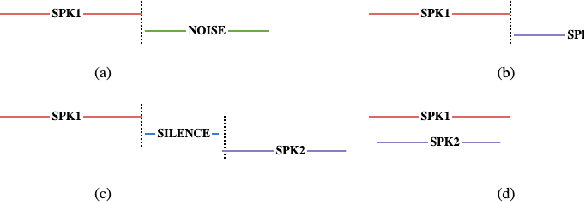
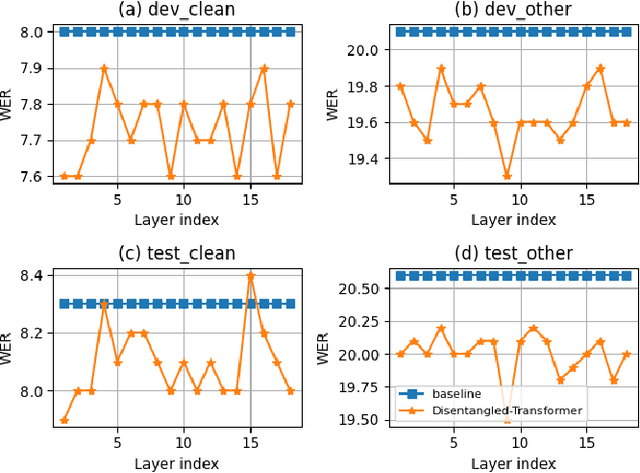

Abstract:End-to-end transformer-based automatic speech recognition (ASR) systems often capture multiple speech traits in their learned representations that are highly entangled, leading to a lack of interpretability. In this study, we propose the explainable Disentangled-Transformer, which disentangles the internal representations into sub-embeddings with explicit content and speaker traits based on varying temporal resolutions. Experimental results show that the proposed Disentangled-Transformer produces a clear speaker identity, separated from the speech content, for speaker diarization while improving ASR performance.
Efficient Extraction of Noise-Robust Discrete Units from Self-Supervised Speech Models
Sep 04, 2024



Abstract:Continuous speech can be converted into a discrete sequence by deriving discrete units from the hidden features of self-supervised learned (SSL) speech models. Although SSL models are becoming larger and trained on more data, they are often sensitive to real-life distortions like additive noise or reverberation, which translates to a shift in discrete units. We propose a parameter-efficient approach to generate noise-robust discrete units from pre-trained SSL models by training a small encoder-decoder model, with or without adapters, to simultaneously denoise and discretise the hidden features of the SSL model. The model learns to generate a clean discrete sequence for a noisy utterance, conditioned on the SSL features. The proposed denoiser outperforms several pre-training methods on the tasks of noisy discretisation and noisy speech recognition, and can be finetuned to the target environment with a few recordings of unlabeled target data.
Unsupervised Online Continual Learning for Automatic Speech Recognition
Jun 18, 2024Abstract:Adapting Automatic Speech Recognition (ASR) models to new domains leads to Catastrophic Forgetting (CF) of previously learned information. This paper addresses CF in the challenging context of Online Continual Learning (OCL), with tasks presented as a continuous data stream with unknown boundaries. We extend OCL for ASR into the unsupervised realm, by leveraging self-training (ST) to facilitate unsupervised adaptation, enabling models to adapt continually without label dependency and without forgetting previous knowledge. Through comparative analysis of various OCL and ST methods across two domain adaptation experiments, we show that UOCL suffers from significantly less forgetting compared to supervised OCL, allowing UOCL methods to approach the performance levels of supervised OCL. Our proposed UOCL extensions further boosts UOCL's efficacy. Our findings represent a significant step towards continually adaptable ASR systems, capable of leveraging unlabeled data across diverse domains.
MSNER: A Multilingual Speech Dataset for Named Entity Recognition
May 19, 2024Abstract:While extensively explored in text-based tasks, Named Entity Recognition (NER) remains largely neglected in spoken language understanding. Existing resources are limited to a single, English-only dataset. This paper addresses this gap by introducing MSNER, a freely available, multilingual speech corpus annotated with named entities. It provides annotations to the VoxPopuli dataset in four languages (Dutch, French, German, and Spanish). We have also releasing an efficient annotation tool that leverages automatic pre-annotations for faster manual refinement. This results in 590 and 15 hours of silver-annotated speech for training and validation, alongside a 17-hour, manually-annotated evaluation set. We further provide an analysis comparing silver and gold annotations. Finally, we present baseline NER models to stimulate further research on this newly available dataset.
Unsupervised Accent Adaptation Through Masked Language Model Correction Of Discrete Self-Supervised Speech Units
Sep 25, 2023



Abstract:Self-supervised pre-trained speech models have strongly improved speech recognition, yet they are still sensitive to domain shifts and accented or atypical speech. Many of these models rely on quantisation or clustering to learn discrete acoustic units. We propose to correct the discovered discrete units for accented speech back to a standard pronunciation in an unsupervised manner. A masked language model is trained on discrete units from a standard accent and iteratively corrects an accented token sequence by masking unexpected cluster sequences and predicting their common variant. Small accent adapter blocks are inserted in the pre-trained model and fine-tuned by predicting the corrected clusters, which leads to an increased robustness of the pre-trained model towards a target accent, and this without supervision. We are able to improve a state-of-the-art HuBERT Large model on a downstream accented speech recognition task by altering the training regime with the proposed method.
Analysis of XLS-R for Speech Quality Assessment
Aug 23, 2023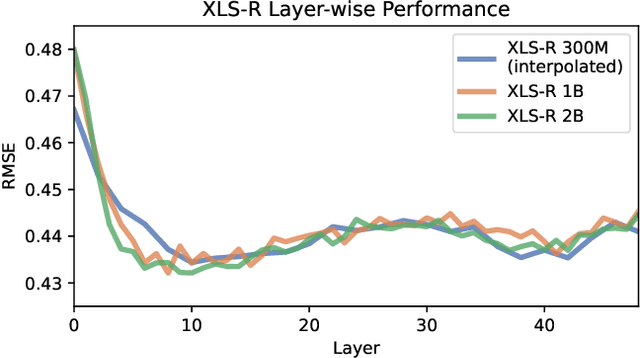
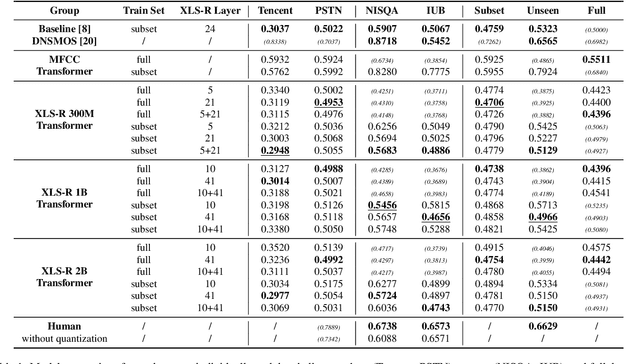
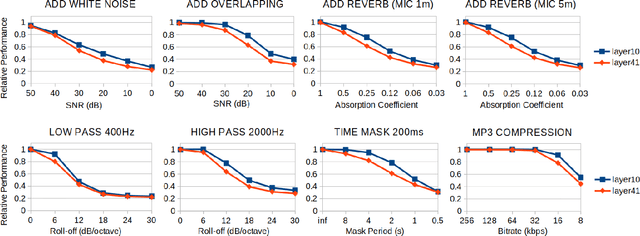
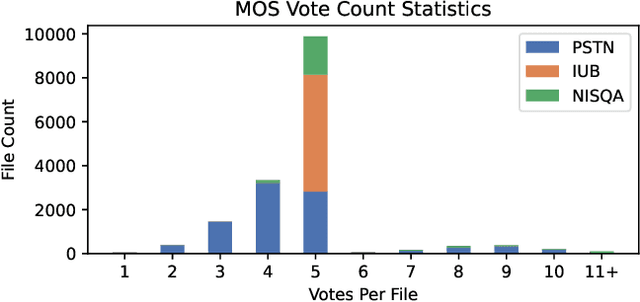
Abstract:In online conferencing applications, estimating the perceived quality of an audio signal is crucial to ensure high quality of experience for the end user. The most reliable way to assess the quality of a speech signal is through human judgments in the form of the mean opinion score (MOS) metric. However, such an approach is labor intensive and not feasible for large-scale applications. The focus has therefore shifted towards automated speech quality assessment through end-to-end training of deep neural networks. Recently, it was shown that leveraging pre-trained wav2vec-based XLS-R embeddings leads to state-of-the-art performance for the task of speech quality prediction. In this paper, we perform an in-depth analysis of the pre-trained model. First, we analyze the performance of embeddings extracted from each layer of XLS-R and also for each size of the model (300M, 1B, 2B parameters). Surprisingly, we find two optimal regions for feature extraction: one in the lower-level features and one in the high-level features. Next, we investigate the reason for the two distinct optima. We hypothesize that the lower-level features capture characteristics of noise and room acoustics, whereas the high-level features focus on speech content and intelligibility. To investigate this, we analyze the sensitivity of the MOS predictions with respect to different levels of corruption in each category. Afterwards, we try fusing the two optimal feature depths to determine if they contain complementary information for MOS prediction. Finally, we compare the performance of the proposed models and assess the generalizability of the models on unseen datasets.
The role of vowel and consonant onsets in neural tracking of natural speech
Jul 31, 2023Abstract:To investigate how the auditory system processes natural speech, models have been created to relate the electroencephalography (EEG) signal of a person listening to speech to various representations of the speech. Mainly the speech envelope has been used, but also phonetic representations. We investigated to which degree of granularity phonetic representations can be related to the EEG signal. We used recorded EEG signals from 105 subjects while they listened to fairy tale stories. We utilized speech representations, including onset of any phone, vowel-consonant onsets, broad phonetic class (BPC) onsets, and narrow phonetic class (NPC) onsets, and related them to EEG using forward modeling and match-mismatch tasks. In forward modeling, we used a linear model to predict EEG from speech representations. In the match-mismatch task, we trained a long short term memory (LSTM) based model to determine which of two candidate speech segments matches with a given EEG segment. Our results show that vowel-consonant onsets outperform onsets of any phone in both tasks, which suggests that neural tracking of the vowel vs. consonant exists in the EEG to some degree. We also observed that vowel (syllable nucleus) onsets are better related to EEG compared to syllable onsets. Finally, our findings suggest that neural tracking previously thought to be associated with broad phonetic classes might actually originate from vowel-consonant onsets rather than the differentiation between different phonetic classes.
Rehearsal-Free Online Continual Learning for Automatic Speech Recognition
Jun 19, 2023

Abstract:Fine-tuning an Automatic Speech Recognition (ASR) model to new domains results in degradation on original domains, referred to as Catastrophic Forgetting (CF). Continual Learning (CL) attempts to train ASR models without suffering from CF. While in ASR, offline CL is usually considered, online CL is a more realistic but also more challenging scenario where the model, unlike in offline CL, does not know when a task boundary occurs. Rehearsal-based methods, which store previously seen utterances in a memory, are often considered for online CL, in ASR and other research domains. However, recent research has shown that weight averaging is an effective method for offline CL in ASR. Based on this result, we propose, in this paper, a rehearsal-free method applicable for online CL. Our method outperforms all baselines, including rehearsal-based methods, in two experiments. Our method is a next step towards general CL for ASR, which should enable CL in all scenarios with few if any constraints.
 Add to Chrome
Add to Chrome Add to Firefox
Add to Firefox Add to Edge
Add to Edge